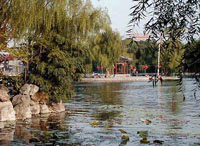 From May to September, visitors to Beijing are recommended to visit the city's hutongs, or lanes, along the banks of Shichahai, where scenes of the old Beijing are still preserved. When the sun is setting in the west, the lake is a pleasant place for visitors to enjoy the cool while savoring tea on an ancient-style wood boat.
From May to September, visitors to Beijing are recommended to visit the city's hutongs, or lanes, along the banks of Shichahai, where scenes of the old Beijing are still preserved. When the sun is setting in the west, the lake is a pleasant place for visitors to enjoy the cool while savoring tea on an ancient-style wood boat.
The heat of summer hesitates to leave Beijing even in September. During the long period of summer, Shichahai is a good place in urban Beijing to seek the cool, especially if you have little time to go to the suburbs.
Because of an arid climate, Beijing is short of water. Shichahai, a big, narrow lake just to the north of Beijing's famed Beihai Park, is like a huge air-conditioner modulating the temperature and humidity of the city. In the surrounding area of Shichahai are residential quarters with strong characteristics of old Beijing: narrow hutongs extend in all directions, compounds that encompass gray-tiled, single-story houses stand in order, and scenes of residents' leisure life are everywhere. All of these http://www.rmhb.com.cn/chpic/htdocs/rmhb/itlia/200211/images take visitors back into Beijing's past.
Hutongs are urban lanes unique to Beijing, mostly dating back to the Yuan (1271-1368), Ming (1368-1644), and Qing (1644-1911) dynasties. Grand hutongs located along the eastern and western sides of the Imperial Palace, stretching from north to south, were once inhabited by noblemen and members of the royal family. The more humble ones were located far from the northern and southern ends of the Imperial Palace and were where the common people resided.
The main residential structure found in hutongs is the siheyuan, a compound with single-story houses placed in the east, the west, the south, and the north around a square courtyard. According to the residents' social status, the compounds vary in scale. While large compounds for high-ranking officials and the wealthy feature finely structured buildings with carved beams and painted rafters as well as sub-yards both in the front and the rear, small compounds for common people are simple, with narrow gates and low surrounding walls. Hutongs are actually passages that link the compounds to one another. When viewed as a whole, the city of Beijing is like a magnified siheyuan that has been symmetrically laid out.
Capital of the Yuan, Ming, and Qing dynasties, Beijing cultivated a group of profligate sons who came from noble families and spent most of their time doing nothing but idle about the hutongs. The residential compounds are virtually an epitome of the Beijingers' lifestyle and social culture back in feudal times.
Since the implementation of the reform and opening policies, tremendous changes have taken place in Beijing. Many hutongs have been replaced by modern buildings. Even so, hutongs still account for one-third of the total area of urban Beijing, and are home to nearly half of the city's population. At present, the Municipal Government of Beijing has become more and more conscious of the importance of protecting the surviving hutongs, which are not only historical and ancestral heritage, but also living culture.
Walking through hutongs and visiting the residential compounds can help visitors understand old Beijing and its traditions, as well as the changes that have taken place in the lives of modern Beijingers.
Because it provides travelers with a panoramic view of the beauty of traditional Beijing, the best destination for a hutong tour is the Shichahai area. The age-old Yinding Bridge spans Shichahai, the oldest lake in Beijing. The hills and buildings nearby are reflected in the lake; and willow branches sway in the breeze along its banks. The mansions of princes, the temples, and the former residences of historically renowned persons add a touch of nobility and antiquity to this area. Viewed from the top of the 700-year-old Drum Tower, hutongs are hidden in between towering trees. People here lead a tranquil life: children play traditional games, elders either stroll around with their bird cages or play chess on street corners, and peddlers bring convenience to the local residents by selling various commodities. With the help of a tour guide, travelers can visit residents' homes and get near to their lives by chatting and having Beijing-flavored meals with them.
Besides the red-topped, black-bodied pedicabs, which are the principle means of transportation around the Shichahai area, ancient-style wood boats are also popular between spring and autumn. Boatmen, wearing bamboo hats and yellow vests, take tourists to different destinations along the lake. As the sun sets, they light up lanterns; and a young girl, sitting at the front of each boat, entertains the tourists with melodious music played on traditional Chinese instruments. While traveling on the boats, tourists can either savor tea and snacks or barbecue food offered by Ji's Grill, a time-honored restaurant on the lake's bank. After night falls, tourists enjoy themselves by releasing paper lanterns into the water while murmuring a vow. The flickering light of the lanterns seems to lead tourists back into the fairly distant past.
How to get there: Bus5 take off at Jiazishi; Bus13 take off at Beihai Houmen(back gate of Beihai); Bus22、27、38、big44、small44 take off at Xinjiekou Huokou.
Tel: 66127652 Add: Xihai-beiyan, Xicheng District.
Entrance Ticket: Free
Suggested travel route: Take a pedicab to visit the Drum Tower--then take a pedicab to Shichahai (the Yinding Bridge, hutongs, and siheyuans)--later, dine at a local resident's home (Beijing-flavored dishes such as dumplings)--after dinner, sightsee on a pedicab and get close to folk activities (card playing, chess playing, yangge dancing, etc.)--finally, travel by boat on the Shichahai lake. (17:00-20:30 every day, from April to October)
(China Pictorial December 11, 2002)
|

